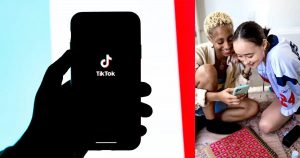It’s no secret that young people gravitate to the newest things, the latest trends and the hottest styles as they grow and establish their individual identities. For many teens and college-age students right now, social media newcomer TikTok stands out as the preferred conduit for watching, creating and sharing short videos.
 Solen Feyissa, Shingi Rice/Unsplash
Solen Feyissa, Shingi Rice/Unsplash
In July, TikTok upped its video length limit from 1 minute to 3 minutes with the goal of supporting even richer storytelling and entertainment. “With all the ways our community has redefined expression in under 60 seconds, we’re excited to see how people continue to entertain and inspire with a few more seconds and a world of creative possibilities,” the company said.
“A lot of times you don’t even have to search for what you’re looking for on TikTok. It’s just there.”
A prime target
With a longer video format to work with and a young user base to tap into, TikTok is a prime target for performance marketers looking to rise above the digital clutter and reach new audiences. Offering a continuous stream of content that users can scroll through, the platform curates the videos for each person based on their viewing history.
“A lot of times you don’t even have to search for what you’re looking for on TikTok,” said one college student. “It’s just there.” She especially likes content such as fashion videos that provide information about where to buy the clothing and accessories, and clips about what to bring to college, where to buy your books and how to manage your time.
TikTok also helps to break down some of the social anxieties that younger consumers may have naturally developed as part of the social media generation. That’s because it’s more helpful and collaborative than other social media platforms. It encourages questions and collaboration, for example, and is known for its supportive, less-judgmental tones.
Finally, TikTok promotes individuality and helps users cope with the stress of the global pandemic and isolation by helping to connect people.
Types of TikTok advertising
Similar to the early days of digital advertising, TikTok creators may display “I’m not being paid for this” disclaimers on their clips, while influencers who create ads label them as such at the bottom of their videos. I would estimate that most of endorsements fall into the first bucket, and are seen as genuine, organic recommendations. And while these may not be official, paid advertising relationships, it’s likely that the creators are getting free products and/or teeing themselves up to become influencers.
Many of these influencers have millions of followers and have previously signed brand deals on platforms like YouTube and Instagram to promote products and services to their audience. “TikTok is no different, and the power of followers can be harnessed the same way,” Ruth Matthews writes in 6 Easy Ways to Use TikTok for Marketing in a Gen Z World.
Because successful content on TikTok isn’t overly curated and relies on user input, influencers can get creative with how they promote brands. “Some examples of this are wearing a piece of relevant clothing or filming themselves using one of your products as part of their day-to-day lifestyle,” Matthews writes.
Still, the balance between brands and influencers over creative license is delicate—and desire to go viral often comes up against a brand’s stricter standards of what it can get behind.
Another opportunity for brands on the platform is ecommerce. TikTok recently announced a partnership with Shopify, including the launch of TikTok Shopping, a partnership with select Shopify merchants. The introduction of new tools will allow Shopify merchants to create, run and optimize their TikTok marketing campaigns directly from the Shopify dashboard. Kylie Jenner is among the early adopters of the new service for her Kylie Cosmetics brand.
Taking that first step
For performance marketers, TikTok is a viable platform for reaching younger consumers and getting their products into the algorithm for recommendations (e.g., back to school, trends, clothing, electronics, etc.) The return on investment can be high because this is where younger audiences are spending their time right now. Meeting them where they are with relevant, useful content and product offerings can be well worth the effort.





